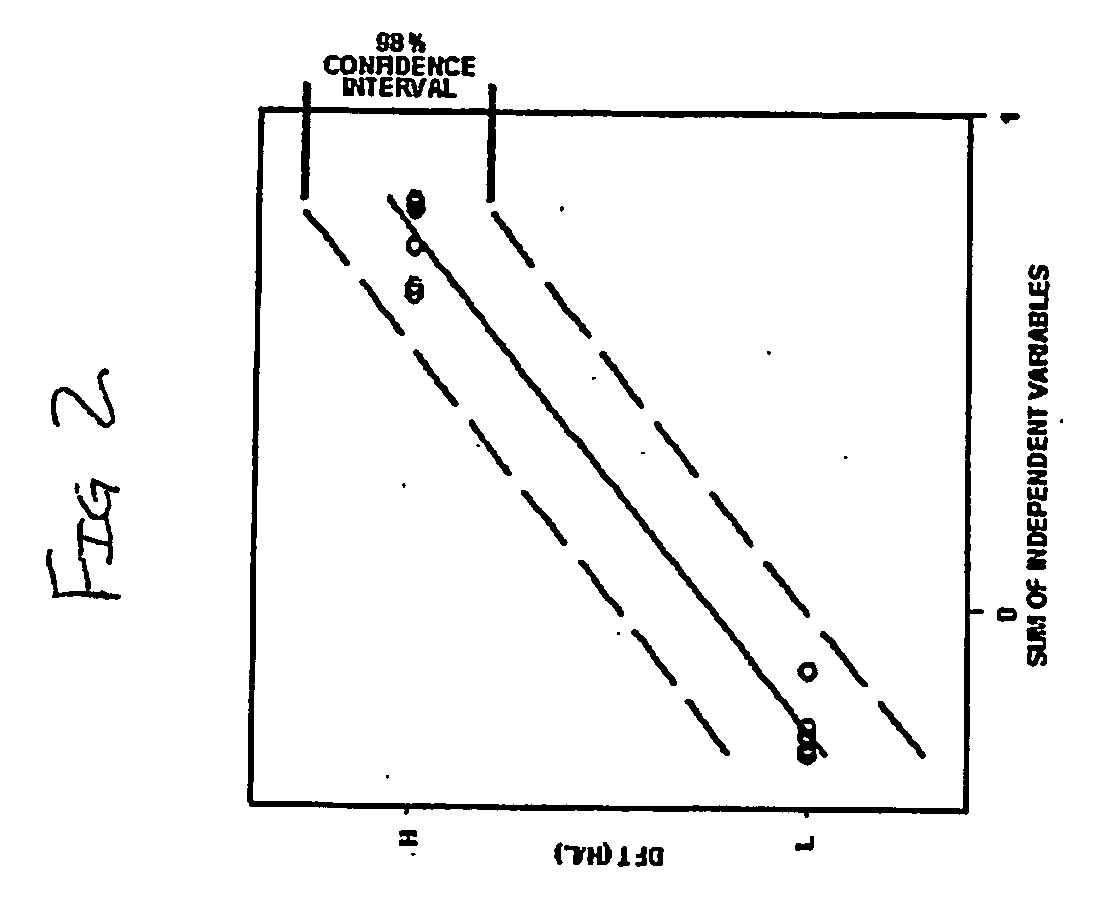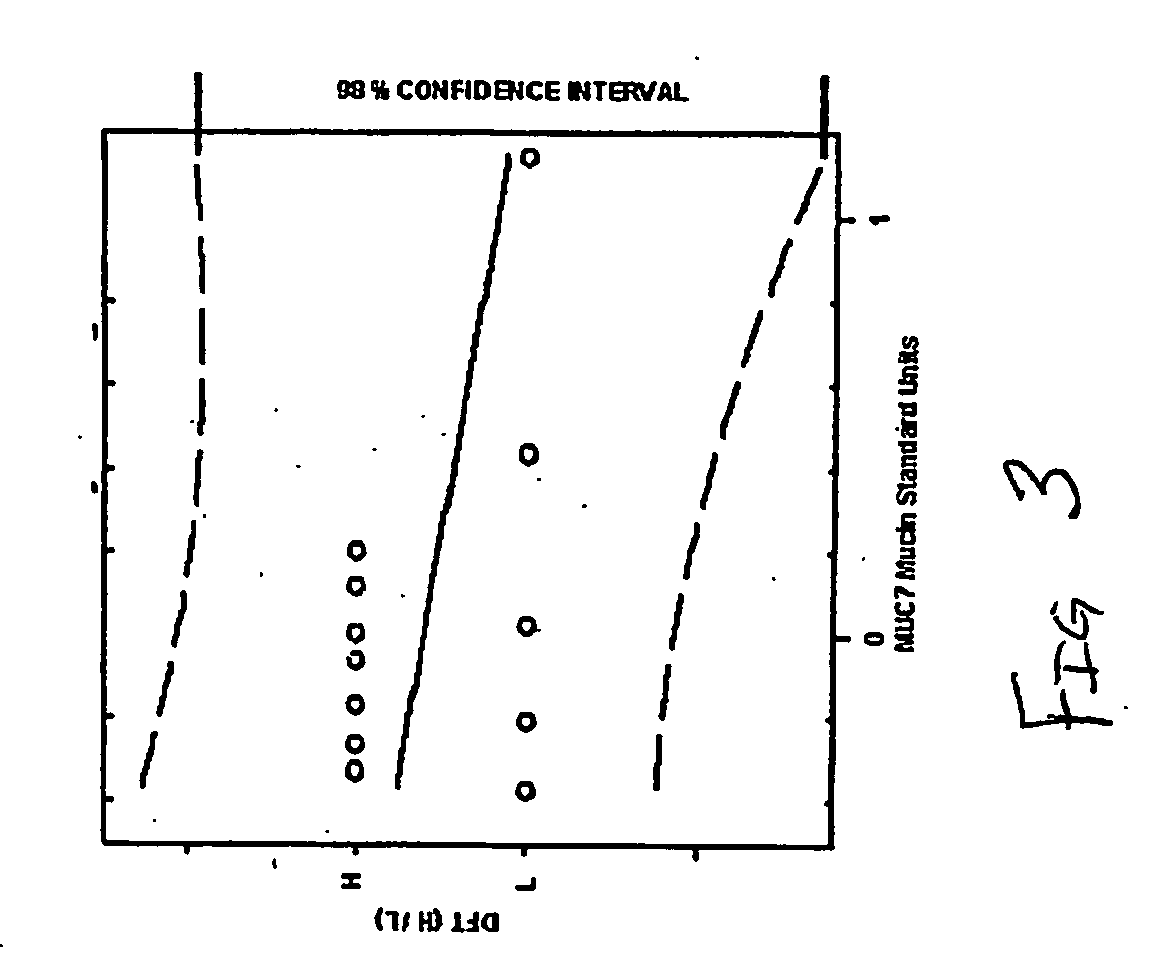Caries risk test for predicting and assessing the risk of disease
a risk test and saliva technology, applied in the field of saliva risk test for predicting and assessing can solve the problems of large amount of time required for methods, large crown mutilation, and inability to relate saliva factors with other common oral diseases, so as to reduce the risk of disease, predict, assess and diagnose the risk of diseas
- Summary
- Abstract
- Description
- Claims
- Application Information
AI Technical Summary
Problems solved by technology
Method used
Image
Examples
example 1
[0209] The first objective of this study was to confirm and extend the inventors' original findings from the 1991 young adult dataset to a contemporary group of similar composition, recruiting 80-100 students at the USC School of Dentistry.
[0210] The second object of this study was to perform a similar study in 7-8 year-old children to learn if the correlations between DFT and mucin concentrations seen in young adults also apply. Analysis of this data provided new insights that are reflected in Example 2.
[0211] The third objective was first to better understand the component of MUC7 and MUC5B mucins which appear to have the best association with the forecast of DFT. A second aspect of this aim was then to incorporate these elements into a prototype test with commercial potential.
A. Carbohydrate Studies Leading to Identification of the Most Predictive Element(s) Related to MUC7 and MUC5B Mucin Concentrations.
[0212] 1. Dot blots: The first objective was to evaluate whether the br...
example 2
[0228] The purpose of this study was to “universalize” and complete development of several iterations of a simple, non-invasive saliva test not only for forecasting individual accumulated caries experience but, more importantly, for assessing levels of risk for future caries development. The test can be integrated into dental practice as a common diagnostic procedure health screening, and in broader oral health campaigns to improve identification, treatment, and prevention in high-risk individuals. The diagnostic screening information provided by these combinations of test and technology will aid the health care provider in identifying caries-prone children, teenagers, and young adults. This will be most helpful at stages of dental development when physical examination alone or dmfs (decayed, missing, and filled surfaces) in deciduous teeth and DMFS in permanent teeth cannot identify with statistical certainty, those individuals who are at-risk.
[0229] Additional factors in saliva, ...
example 3
A Lectin-Based Four Level Caries Risk Test
[0251] This study demonstrated that certain combinations of lectins, such as MAL I, JAC and SNA, together with gender information, yields a good correlation with DFT in a statistical anaylsis by regression. This model provides four statistically different groups: high, medium, low and zero DFT into which a tested individual can be placed.
1. Saliva Panel-Dot Blot Assay:
[0252] a) This study is a continuation with the same subjects listed in table 3, using an alternative version of the high through-put assay system (HTP) of this invention. A notable advance from this study was the achievement of an all lectin system, i.e., MAL I, JAC, and SNA. When combined with age and ethnicity, this system forecasts DFT (decayed and filled permanent teeth) in the ages 7-26 years-old with an R2 of 0.926 (FIG. 7). While this accomplishment is interesting, it does not have the potential for risk assessment because it tends to put DFT in numerical order rath...
PUM
| Property | Measurement | Unit |
|---|---|---|
| time | aaaaa | aaaaa |
| molecular weights | aaaaa | aaaaa |
| diameter | aaaaa | aaaaa |
Abstract
Description
Claims
Application Information
 Login to View More
Login to View More - R&D
- Intellectual Property
- Life Sciences
- Materials
- Tech Scout
- Unparalleled Data Quality
- Higher Quality Content
- 60% Fewer Hallucinations
Browse by: Latest US Patents, China's latest patents, Technical Efficacy Thesaurus, Application Domain, Technology Topic, Popular Technical Reports.
© 2025 PatSnap. All rights reserved.Legal|Privacy policy|Modern Slavery Act Transparency Statement|Sitemap|About US| Contact US: help@patsnap.com



